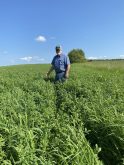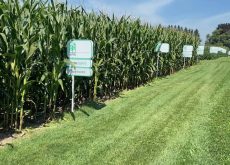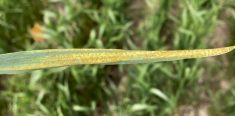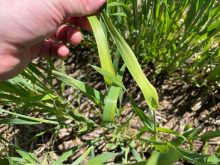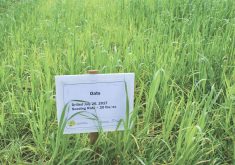While most Ontario dairy producers are watching alfalfa stands and the weather forecast to determine the ideal date for first cutting, several others are eyeing different crops – mainly fall-planted grasses or small grains – as their first 2021 opportunity to add to forage feedstocks.
Throughout the growing season, depending on rainfall and the degree of alfalfa winterkill, alternative forage crops will continue to play a role on many dairy operations.
Why it matters: There’s increasing concern about the proliferation of Bt resistance in corn fields, leading to more discussion about alternative forages to corn.
Read Also
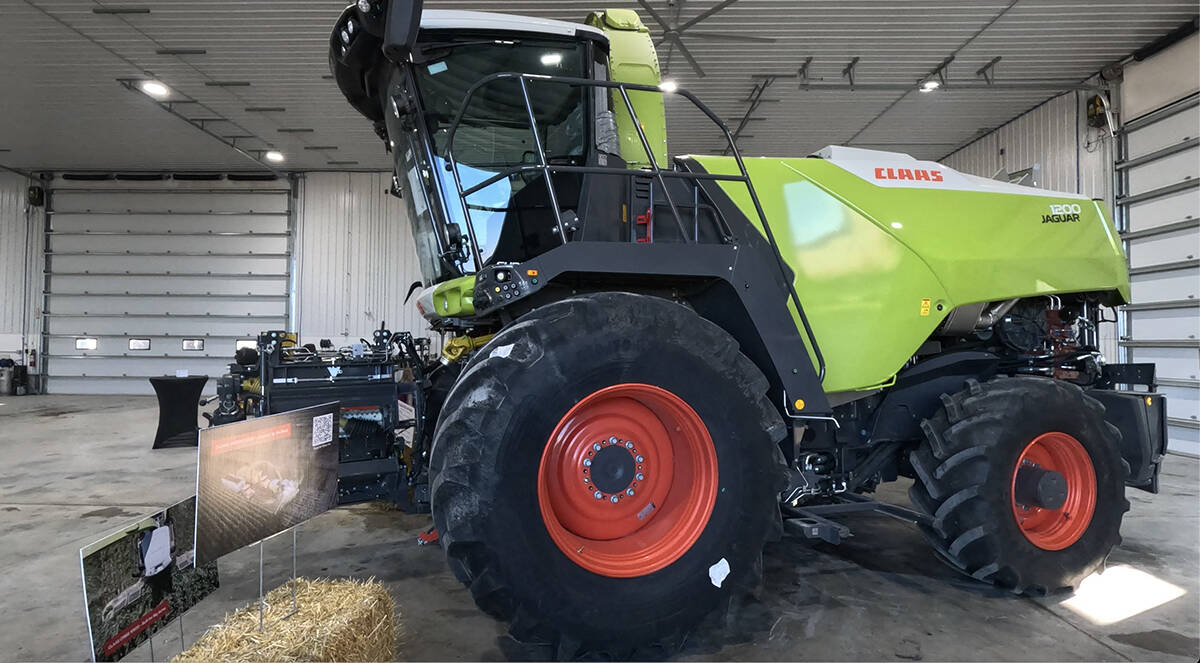
Claas brings 1000 Series SP forage harvesters to Canada
In mid-August, Claas unveiled its new line of Jaguar forage harvesters at an event in Visalia, California, deep in the heart of that state’s dairy region.
A recent webinar hosted by the Ontario Ministry of Agriculture Food and Rural Affairs (OMAFRA) highlighted the potential for alternative forage crops to break the cycle of corn rootworm Bt trait resistance on dairy operations, and there are numerous farmers already putting the strategy effectively into practice.
OMAFRA’s Christine O’Reilly was one of the main presenters during that webinar and, in a subsequent conversation with Farmtario, she noted that “sorghum-sudangrass acres have increased dramatically in Ontario in the last few years. I don’t have numbers on what the acreage is, but that is the trend that the forage seed suppliers I know have commented on.”
Ryegrass is also an increasingly popular option. Norwich-area producer Roger Wikkerink is probably one of the crop’s best-known Ontario proponents. He relocated his dairy herd from Vancouver Island in 2002 and deciding to stick with the grass-based diet the cows had thrived on before their move.
With sorghum-sudangrass, O’Reilly noted, weather in 2018 and 2019 was probably a factor. “The cool, wet springs contributed,” she said. “As corn planting was delayed and producers started looking for a shorter-season crop. High levels of alfalfa winterkill in the 2018-2019 winter also encouraged sorghum-sudangrass stands in 2019 as a rotation crop out of alfalfa.”
A blog post from last spring by Quality Seeds forage specialist Joel Bagg advised an “emergency option” of seeding sorghum-sudangrass “when thin, low yielding winterkilled alfalfa stands are not identified until after a disappointing first-cut.” The crop, he said, “can also be planted into unseeded soybean and corn acres during a wet year to provide additional forage.”
Bagg said planting shouldn’t occur until the soil is quite warm – into late May or early June. “These warm-season annual grasses do best in hot summer weather with adequate moisture, but are also more drought tolerant than other forage species.”
And when the frost comes, prussic acid toxicity can occur – definitely a red flag in pasturing applications but less so when harvested as forage.
Managing ryegrass
Goderich-area dairy farmer and Quality Seeds sales representative Glen MacNeil says weather also contributes to decision-making about ryegrass. Heather Holme Holsteins first planted ryegrass in 2012, as drought threatened corn and alfalfa-based feedstocks. “It was an absolute saviour.”
Another year, he had a severely winterkilled field of alfalfa into which 20 pounds per acre of ryegrass was interseeded in May. “It just got us through. It grew and it made good feed.”
Ryegrass comes in a few forms. For decades, Westerworld predominated but it forms a head as soon as warm weather comes so is often only good for one cut of high-quality feed. Newer annual varieties don’t form heads as readily. And Italian ryegrass acts somewhat like a perennial, giving it potential as a late summer or fall-planted option.
MacNeil likes the flexibility – both in agronomics and at harvest time – that ryegrass affords. Heather Holme typically seeds at 40 pounds per acre in the first weekend in August, usually following wheat harvest. “I would never plant it in July because it tends to be too dry then” for good germination.
“It comes up very, very thick and, as a result, no weeds,” he said. For fertility, they use 60 units of actual N, “and that just turns it on like a lightbulb.”
Their ideal window for the first harvest is the Thanksgiving weekend but they have cut it as late as the Royal Winter Fair in early November. With ryegrass planted in August, it maintains its quality through October and even over the winter into April, MacNeil says. It may only get knee-high, “but when you start to cut it, you’ll be amazed at the size of the swath.”
Ideally, it goes into the bunker or bag at 50 per cent moisture. But going with 65 per cent is fine. The feed quality is the same; it’s just a little harder to handle because it’s heavier. “It’s so flexible.”
He said the fall-harvested ryegrass typically has 21 to 24 per cent protein and has high digestibility with as much energy as corn silage.
Typically, after overwintering, they harvest again on the May 24 weekend, with protein at 16-17 per cent. MacNeil usually tries to double-crop with soybeans but ryegrass’s strong regrowth definitely needs to be addressed with spraying within the first couple of weeks after planting.
“But if you choose to leave it, put on another 50 units of N and harvest every 28 days,” he added. There’s potential for six cuts. “But it needs rain. What ryegrass really likes is cool, damp weather. That’s why it does so well in the fall.”
Wikkerink, who also sells for Speare Seeds, uses a similar strategy with Italian ryegrass, as well as sometimes adding fall-planted triticale to the rotation. Triticale is less susceptible to winterkill, and also less likely to grow back after springtime harvest and cause problems for the subsequent crop. But the fall harvest doesn’t have the same potential.
Wikkerink’s make-or-break date for planting is Sept. 15 and he wants to see the first harvest by the end of October. After spring harvest, he sometimes double-crops with a shorter-day corn silage variety.
He advises that a fall harvest isn’t necessary, and usually translates into a lower spring yield. But if not cut in the fall, it sometimes lies down as a mat, increasing risk of winterkill.
Even if springtime yields are disappointing, MacNeil notes the crop’s fibrous roots “are really good for soil structure.” So there should be benefits for the subsequent crop.
“If nothing else, it’s a good cover crop,” Wikkerink agreed.
He concedes that alfalfa “gives you a little bit more of a window” for maintaining feed quality at harvest time. The grasses have high sugar content when cut in the vegetative state, but that quality can quickly degrade if they’re left too long in the swath.
“We’re pretty adamant about cutting it and putting it in (the bunker) in one day,” stressed Wikkerink. It’s fed as part of the farm’s TMR. “Your digestibility is always really good.”
A lot of what he sells is Barenbrug. MacNeil, with Quality Seeds, sells a lot of Evolution – a blend of Italian ryegrass and conventional ryegrass.




